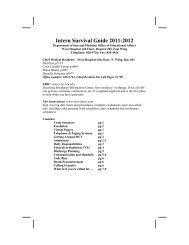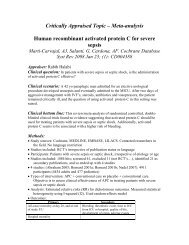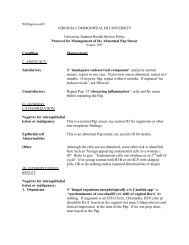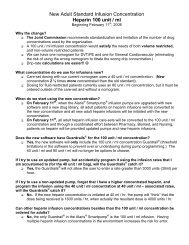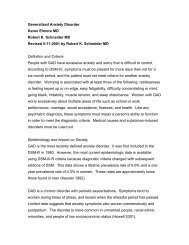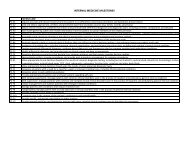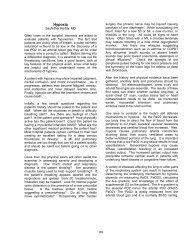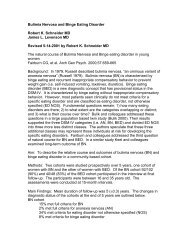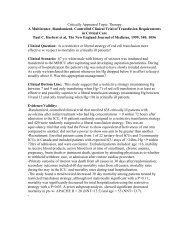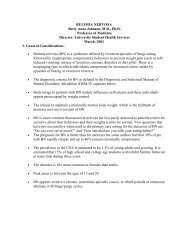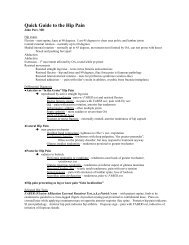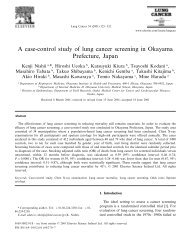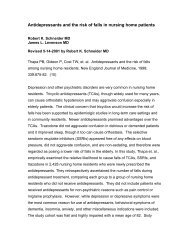Celiac Disease - VCU Internal Medicine Electronic Residency ...
Celiac Disease - VCU Internal Medicine Electronic Residency ...
Celiac Disease - VCU Internal Medicine Electronic Residency ...
You also want an ePaper? Increase the reach of your titles
YUMPU automatically turns print PDFs into web optimized ePapers that Google loves.
Chief’s s Conference<br />
John Port, MD<br />
October 3-4, 3<br />
2006
<strong>Celiac</strong> <strong>Disease</strong> - Definition<br />
a.k.a. “celiac<br />
sprue” or<br />
“gluten-sensitive<br />
enteropathy”<br />
“A A common autoimmune disorder characterized by<br />
an immune response to ingested wheat gluten<br />
and related proteins of rye and barley that leads<br />
to inflammation, villous atrophy, and crypt<br />
hyperplasia in the small intestine.”<br />
Alaedini Ann Intern Med. . 2005;142:289-298<br />
298
<strong>Celiac</strong> <strong>Disease</strong> - Background<br />
• Prevalence<br />
-much greater than previously estimated<br />
-approaches 1% in US and Europe<br />
-the most common genetic disease in Europeans<br />
-rare among African-Caribbean, Chinese, Japanese<br />
• Strong genetic susceptibility<br />
-75% concordance in monozygotic twins<br />
-4-12% prevalence among first-degree relatives<br />
• Age - 20% of cases diagnosed in people over age 60,<br />
most new cases between ages 10-40<br />
• Sex - slight female preponderance
<strong>Celiac</strong> <strong>Disease</strong> - Subphenotypes<br />
Classical celiac disease – GI malabsorption<br />
symptoms and sequelae, , positive serology,<br />
villous atrophy, improvement with gluten-free<br />
diet<br />
<strong>Celiac</strong> disease with “atypical” symptoms –<br />
mostly extraintestinal symptoms, positive<br />
serology, villous atrophy, improvement with<br />
gluten-free diet. May be the most common<br />
presentation!
<strong>Celiac</strong> <strong>Disease</strong> - Subphenotypes<br />
Silent <strong>Celiac</strong> disease – asymptomatic. Positive<br />
serology, villous atrophy. Detected by screening<br />
high risk individuals or by biopsy for another<br />
reason.<br />
Latent <strong>Celiac</strong> disease – asymptomatic. Positive<br />
serology only. . (normal biopsy)<br />
-> > The clinical significance of these subtypes<br />
remains unclear
Associated Conditions<br />
Gastrointestinal<br />
• Recurrent abdominal pain (27%) or distention<br />
• Chronic diarrhea (28%) or constipation<br />
• Weight loss or failure to grow<br />
• Bloating and distension<br />
• Anorexia<br />
• Protein calorie malnutrition (hypoalbuminemia(<br />
hypoalbuminemia)<br />
• Vitamin deficiencies (ADEK, folate, , B12, Ca, iron)<br />
• Autoimmune hepatitis or cholangitis (unexplained<br />
mild transaminitis)<br />
• Primary biliary cirrhosis<br />
• Hyposplenism
Associated Conditions<br />
Dermatologic<br />
• Dermatitis Herpetiformis<br />
-affects 10-20% of patient with celiac disease<br />
-bilateral<br />
pruritic, papulovesicular lesions on<br />
extensor surfaces<br />
-IgA<br />
deposits in dermal papillae<br />
-always associated with intestinal inflammation<br />
• Angular chelitis - associated with vitamin B, iron def.<br />
• Apthous stomatitis -associated with B12, iron, folate<br />
deficiency<br />
• Dental enamel defects
Dermatitis Herpetiformis
Associated Conditions (cont’d)<br />
Hematologic<br />
• Iron deficiency anemia<br />
-may be the most common presentation of celiac<br />
disease!<br />
- one study of 103 white patients with iron deficiency<br />
anemia undergoing panendoscopy showed that<br />
9 patients (8.7%) had histiologic celiac disease.<br />
IDA improved with gluten-free diet. (Grisolano<br />
Grisolano, , et al. 2004)<br />
• Selective IgA deficiency (1.7-2.6%, 10-16X 16X general pop.)<br />
• Coagulopathy (rare, from vit. . K deficiency)
Associated Conditions (cont’d)<br />
Endocrine<br />
• DM Type I (5-10%)<br />
– transglutaminase in islet<br />
cells<br />
• Autoimmune thyroid disorders (5-10%)<br />
• Addison <strong>Disease</strong><br />
• Reproductive disorders / Recurrent fetal loss<br />
• Osteopenia / osteoporosis<br />
• Alopecia areata
Alopecia Areata
Associated Conditions (cont’d)<br />
Neurologic/Psychiatric<br />
• Peripheral Neuropathy<br />
• Epilepsy w/ occipital calcifications<br />
• Migraine Headache<br />
• Cerebellar Ataxia – hypoperfusion Protein deposition<br />
• Depression (10.6%)<br />
• Chronic malaise<br />
• Anxiety<br />
Cardiac<br />
• Idiopathic dilated cardiomyopathy<br />
• Autoimmune Myocarditis
Associated Conditions (cont’d)<br />
Rheumatologic<br />
• Joint pain (26%)<br />
• Sjogren syndrome<br />
• Juvenile chronic arthritis<br />
• Carpal tunnel syndrome<br />
• Rheumatoid Arthritis<br />
Genetic/Developmental<br />
• Turner syndrome<br />
• Down syndrome<br />
• Williams syndrome<br />
• Delayed puberty<br />
• Short stature
Associated Conditions (cont’d)<br />
Oncologic<br />
• Non-Hodgkin lymphoma<br />
• Enteropathy associated T-Cell T<br />
Lymphoma<br />
• Adenocarcinoma of small intestine<br />
• Squamous cell carcinoma of esophagus and<br />
oropharynx
Who should be screen for CD<br />
Green and Jibri. <strong>Celiac</strong> <strong>Disease</strong>.<br />
Annual Review of <strong>Medicine</strong> 2006
Diagnosing <strong>Celiac</strong> <strong>Disease</strong><br />
• First must have high degree of suspicion!<br />
• No single test can definitively diagnose or<br />
exclude celiac disease<br />
• All testing MUST be performed while patient is<br />
on gluten-containing diet<br />
• Combination of positive serologic tests and<br />
intestinal (or skin) biopsy features are necessary<br />
to make presumptive diagnosis.<br />
• Definitive diagnosis requires resolution of<br />
symptoms with gluten-free diet<br />
• Beware of concomitant IgA deficiency!
Diagnosis - Serology<br />
• Sensitivity and specificity varies by lab<br />
• <strong>VCU</strong> Medical Center Serologies done by<br />
Prometheus Labs in San Diego, California<br />
• Data listed below compiled by rigorous<br />
systematic review of available assays by the<br />
Agency of Healthcare Research and Quality in<br />
2004<br />
• “Relative agreement” compares Prometheus lab<br />
assays to other assays
Diagnosis - Serology<br />
Antihuman-Tissue<br />
Transglutaminase (tTG) IgA<br />
ELISA assay<br />
uses human or guinea pig<br />
sensitivity > 90%<br />
specificity > 95%<br />
relative agreement 96.2%<br />
cost $76.50<br />
Anti-Endomysial<br />
(EMA) IgA<br />
Immunofluorecence assay<br />
uses human umbilical cord or monkey esophagus<br />
sensitivity > 90%<br />
specificity > 95%<br />
relative agreement 99%<br />
cost $132.50
Diagnosis - Serology<br />
Anti-Gliadin<br />
(AGA) IgA<br />
ELISA assay<br />
sensitivity 80%<br />
specificity 80-90%<br />
relative agreement 97.4%<br />
cost $28<br />
Anti-Gliadin<br />
(AGA) IgG<br />
ELISA assay<br />
sensitivity ~80%<br />
specificity ~80%<br />
however, PPV may only be 2%!<br />
relative agreement 81.7%<br />
cost $28
Diagnosis - Serology<br />
Anti-Endomysial<br />
(EMA) IgG<br />
helpful if IgA deficient<br />
sensitivity ~40%<br />
specificity > 95%<br />
not offered by Promethius labs<br />
Antihuman-TissueTransglutaminase<br />
(tTG) IgG<br />
sensitivity ~40%<br />
specificity >95%<br />
not offered by Promethius lab<br />
Total Serum IgA<br />
cost $25
Diagnosis – Intestinal Biopsy<br />
• Biopsy 2 nd or 3 rd portion of duodenum<br />
• Multiple biopsies should be obtained since disease may<br />
be patchy<br />
• Histologic features: villous atrophy, crypt hyperplasia ,<br />
increased intraepithelial and lamina propria lymphocyte<br />
count, dissarray of enterocytes.<br />
• Some of these features can be seen in giardiasis, , milk<br />
intolerance, tropical sprue, marasmus, , GVHR<br />
• Graded on Marsh scale (0-4).<br />
• Some degree of villous atrophy (Marsh type 3) is<br />
necessary to confirm diagnosis<br />
• May require several pathologists to review slides
Histopathology of <strong>Celiac</strong> <strong>Disease</strong><br />
Duodenum – <strong>Celiac</strong> dz<br />
Epithelial Cells – <strong>Celiac</strong> dz<br />
Normal duodenum<br />
Farrell et al, NEJM 2002
Diagnosis – HLA Typing<br />
HLA DQ2 or DQ8<br />
• can help risk-stratify stratify indeterminate results<br />
• May help detect asymptomatic susceptible relatives<br />
• high negative predictive value<br />
-positive in 96-99% 99% of patients with<br />
celiac<br />
disease<br />
-HLA DQ8 is positive in 30-40% of general<br />
population<br />
• cost $440
Proposed algorithm for evaluation of patients in<br />
whom celiac disease is suspected<br />
Alaedini, A. et. al. Ann Intern Med 2005;142:289-298
Completing the Diagnosis<br />
• Trial of gluten free diet<br />
- complex and difficult to maintain<br />
- avoid wheat, rye, barley<br />
- limit lactose intake until remission<br />
- safe foods include pure rice, corn, soybean,<br />
meats, beans, sugar, fruit and vegetables<br />
• 70% improve within 2 weeks<br />
• May take 6 months to improve lesions
Forbidden Foods!
CELIAC DISEASE<br />
A<br />
Lifetime Without<br />
Beer



